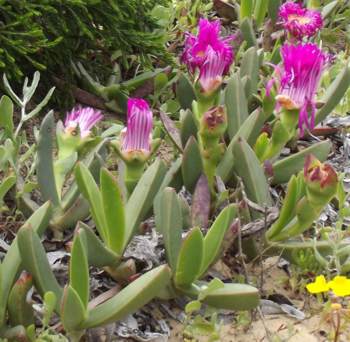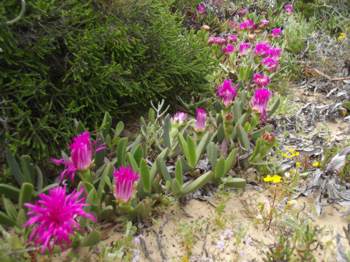Carpobrotus quadrifidus
Carpobrotus quadrifidus L.Bolus (= Carpobrotus sauerae Schwantes)
Family: Aizoaceae
Common names: West Coast sour fig, eland sour fig (Eng.); Weskus suurvy, elandsvy (Afr.)
Introduction
Carpobrotus quadrifidus, formerly named C. sauerae, stands out in the varied conglomeration of mesembs as the one species with the largest flowers.

Description
Description
Carpobrotus quadrifidus is a robust succulent perennial with smooth, straight, trailing stems that can easily attain a length of 2.5m. These prostrate stems form dense mat-like matrixes of less than 500mm in height and root readily at nodes where they touch the soil. The leaves are somewhat fused at the base, opposite, straight, 18-25mm in diameter and sharply three-angled (triangular in cross section), with a sharp point. Leaf colour varies from shades of green to glaucous (blue-grey).

Short, more or less upright flowering branches arise from the main stems on which the exceptionally large flowers of up to 140mm across are born from early spring starting in August through to January. The flowers are born singly on straight to sometimes angled stalks, each with a pair of toothed bracts near its midpoint and with five leaf-like sepals. Flower colour varies from shades of pink to white or purplish.
When ripe, the seeds turn brown. The seeds are embedded in a sticky syrup-like pulp inside the fruit capsule that contains fleshy walls and lack valves. The fruit capsules eventually dry out with age but never open as in most other mesembs.
Conservation Status
Status
Carpobrotus quadrifidus is not threatened.
Distribution and habitat
Distribution description
Carpobrotus quadrifidus is found on coastal rocks, sandy duneveld and coastal subtropical thickest on the west coast of South Africa. The species is confined to the western coastal fog-belt in the winter-rainfall area of the Western and Northern Cape. This region is generally flat and characterised by moderate to low rainfall with semi-arid to arid climatic conditions.

Derivation of name and historical aspects
History
The genus name Carpobrotus has its origin in Greek from the word karpos meaning 'fruit', and brotos meaning 'edible'. This refers to the edible fruits of most members of this genus. The species epithet quadrifidus means 'divided into four parts' and refers to the four calyx lobes of the flowers. The developing fruits of Carpobrotus somewhat resemble in shape the fruits of Ficus species of the family Moraceae commonly known as figs. In Afrikaans figs are known as vye and therefore Carpobrotus quadrifidus are known as elandsvy (after the large antelope) or Weskus suurvy (West Coast sour fig).
The genus Carpobrotus consists of 13 species found in southern Africa, Chile, California and Australia. Six species occur in the Cape fynbos.
Ecology
Ecology
The entire plant is edible and relished by various animals such as tortoises and mammals such as hare, baboons and several small and large antelope.
The dense stands of Carpobrotus quadrifidus form ideal micro-habitats for several rodents, insects and reptiles which find shelter underneath the trailing branches. Seeds of many plants also benefit from the cooler, moister conditions which exist inside or underneath the plants and will germinate more successfully inside the extensive clumps of C. quadrifidus plants. The importance of C. quadrifidus and other perennial plants occurring in sandy areas can therefore not be overemphasised as they play a vital role in dune rehabilitation and the general ecology of coastal vegetation. Carpobrotus quadrifidus, as with other members of the genus, utilises its bright flower colour to attract pollinators such as bees, beetles and ants, and once the fruits have ripened, mammals willingly feed on the ripe and dried fruits in the late summer.
Whereas seed dispersal in other mesembs occurs through wind and rain, in Carpobrotus a different strategy is used. Once fruits are eaten, the seeds are carried through the digestive systems of the animals and, when excreted, germinate readily provided sufficient rain has fallen.

Uses
Use
The sap from the leaves is astringent and has been used medicinally, especially as an antiseptic to treat sore throat and problematic skin conditions, cuts and burns. Unlike the fruits of the closely related Carpobrotus edulis, which are relished by the Cape people, the fruits of C. quadrifidus are less favoured for eating.
As already mentioned, C. quadrifidus and other perennial plants occurring in sandy areas play a vital role in dune rehabilitation and the general ecology of coastal vegetation.
Growing Carpobrotus quadrifidus
Grow
Carpobrotus quadrifidus is easily grown from cuttings or simply from dividing the rooted nodes. Seeds germinate easily when sown in a coarse sandy soil, but care must be taken not to over-water seedlings, as they are prone to fungal disease. Plants thrive in open sunny positions particularly on embankments, retaining walls, along bed edges and in rocky areas, and can be grown in a variety of climatic conditions.
References
- Goldblatt, P. & Manning, J.C. 2000. Cape plants. A conspectus of the Cape flora of South Africa. Strelitzia 9. National Botanical Institute, Cape Town & Missouri Botanical Garden, St. Louis.
- Le Roux, A. 2005. Namaqualand. South African Wild Flower Guide 1. Botanical Society of South Africa, Cape Town.
- Smith, C.A. 1966. Common names of South African plants, Memoirs of the Botanical Survey of South Africa No. 35.
- Smith, G.F., Van Jaarsveld, E., Hammer, S., Chesselet, P., Hartman, H., Burgoyne, P., Van Wyk, B-E. & Kurzweil, H. 1998. Mesembs of the world . Briza, Pretoria.
- Van Wyk, B. & Gericke, N. 2000. People's plants . Briza, Pretoria.
Credits
Werner Voigt
Karoo Desert National Botanical Garden
February 2014
Plant Attributes:
Plant Type: Ground Cover, Succulent
SA Distribution: Northern Cape, Western Cape
Soil type: Sandy
Flowering season: Spring, Early Summer
PH:
Flower colour: Purple
Aspect: Full Sun
Gardening skill: Easy
Special Features:
Horticultural zones









Rate this article
Article well written and informative
Rate this plant
Is this an interesting plant?
Login to add your Comment
Back to topNot registered yet? Click here to register.